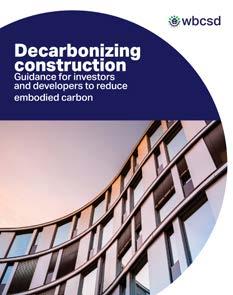
9 minute read
CONSTRUCTION
BUILDING A BIO-BASED CIRCULAR ECONOMY
The global challenge of moving to a sustainable economy involves shifting away from a linear extractive, non-renewable economy. A transition from a fossil- to a bio-based economy has the potential to answer the demands of rapid urbanisation while reducing the carbon footprint of cities and infrastructure.
Advertisement
Proceeding in a sustainable way, a bio-based economy can become one of the possible pathways towards circularity in the buildings sector. The world has continued to use natural resources unsustainably1. The Covid-19 pandemic has offered an opportunity to develop recovery plans that build a more sustainable future. A bio-based economy, where construction materials are produced from renewable biomass, can engage construction sectors at a local scale, transitioning away from global supply chains.
How we produce materials can greatly impact greenhouse gas emissions, in addition to having impacts on ecosystems and pollution. A recent International Resource Panel report2 emphasises the strong interrelationship between the production and use of construction materials and human-caused climate change. It highlights how the production of energy-intensive, mineral-based construction materials leads to greenhouse gas emissions. However, efforts within the buildings sector to mitigate emissions and to adapt to climate change will still require the production and use of materials. Therefore, factors that determine greenhouse gas emissions include: 1) which materials are used, 2) how these materials are sourced and 3) how they are produced and used.
To achieve transformative environmental effects, several construction sector industries and policymakers recognise the need to make a biobased economy viable and sustainable at a large scale3. Policymaking will play a key role in catalysing such transformation by enabling the manufacturers of new bio-based and sustainable building products to industrialise their products successfully and competitively at scale. Policies are crucial in subsequently enabling and incentivising the use products in the construction industry.
A bio-based economy has the potential to generate new industries and employment. Given that biomaterials for construction are “local” or “context-specific,” opportunities for job creation and technological innovation would take effect at the local scale, supporting local economies and societies4. These promising opportunities are especially relevant for Covid-19 recovery plans. Bio-based materials are also linked to potential health benefits, such as the use of green chemistry and green engineering principles in the design of, for example, bio-based resins for wood treatment to offer an alternative to toxic materials, such as some synthetic resins that may release volatile organic compounds; this would contribute to healthier indoor air conditions, including better air quality as well as temperature and humidity control5 .
According to the International Resource Panel6, the production of materials in the global economy contributed 11 gigatons of carbon dioxide equivalent, or 23% of total greenhouse gas emissions, in 2015. Of that share, 32% was for producing iron and steel, 25% for cement, lime and plaster, 13% for rubber and plastics, and 13% for other nonmetallic minerals. Such material production fails to close the loop on waste generation, as it is typically associated with a linear process that relies heavily on the energy-intensive extraction, manufacturing and transport of non-renewable, mineral-based resources.


Bamboo filament is a biodegradable material that can be used for many construction applications such as structural and non-load-bearing walls, roofing, interior panels and flooring.


84 Harrington Street, developed by Hemporium and Afrimat Hemp, is the world’s tallest building being constructed using hempcrete blocks and hemp building materials.





CIRCULAR PRODUCTION
Failing to fundamentally challenge mainstream approaches related to the unsustainable production and consumption of construction material supply chains hampers the capability to foster systemic change. The key to the circular economy is that it takes a systemic approach in aiming to redesign an economy. The circular economy can be defined as a process to improve material efficiency, primarily by closing the resource loop and reducing material waste at the end-oflife of a material.
Achieving circularity involves following a set of principles. According to the Ellen MacArthur Foundation (2020), the first principle is to “design out waste and pollution,” the second is to “keep materials and products in use,” and the third is to “regenerate natural systems.” Haas et al. (2015) note that implementing these three basic principles across the economy implies an extensive overhaul to the basic structure of industrial systems.
Traditional material production practices are associated with the extraction of raw materials and with energy-intensive processes that contribute to global greenhouse gas emissions. According to the OECD (2019), global materials use is projected to more than double from 79 gigatons in 2011 to 167 gigatons in 2060. More than half of the total materials currently in use are non-metallic minerals used in construction, such as sand, gravel and limestone.
The global extraction and production of construction materials, such as metals and concrete, results in a wide range of environmental impacts. Iron and steel have the highest absolute environmental impacts due to their large volume of use; concrete has smaller impacts per kilogram, although it is also used in large volumes, making it responsible for 9% of total greenhouse gas emissions7 .
From a circular economy perspective, promising research and initiatives demonstrate that construction, renovation and demolition residues, which include materials that have already been



Nanotechnology is proving to be beneficial for the construction industry. Several applications have been developed to improve the durability and enhance performance of construction components, energy-efficiency and buildings safety.
extracted and used in a building, can be re-used, extending their life span. Many biomaterials “design out” waste – for example, using postagricultural waste materials such as rice, straw, corn and coconut husk – providing new solutions to the need for immediately available building materials. Other bio-based materials include sheep wool and recycled textiles (for insulation), wood wool, hemp and nature-based materials, such as the use of linseed oil (flaxseed) in the production of linoleum flooring.
Biomaterials are typically local or “climate specific,” offering appropriate performance characteristics in response to passive design strategies, while providing additional income streams to local economies. They eliminate the need for mining of construction minerals, thereby reducing extractive processes and offering an alternative that is typically biodegradable at the end-of-life, helping to regenerate natural systems.
REFERENCES
1. Organisation for Economic Co-operation and Development [OECD] 2019; IRP 2020; United Nations Economic and Social Council 2020 2. IRP 2020 3. Hill, Dibdiakova and Zukowska 2019 4. Mussatto 2017 5. Zimmerman et al. 2020 6. IRP 2020 7. OECD 2019 Hempcrete blocks by Afrimat Hemp.

*This article is an excerpt from the report BIOMATERIALS SUPPORTING THE TRANSITION TO A CIRCULAR BUILT ENVIRONMENT IN THE GLOBAL SOUTH | Yale University | UN Environment Centre [2022]
THOUGHT [ECO]NOMY
READ REPORT
greeneconomy/report recycle
A PRACTICAL GUIDE TO CLIMATE RESILIENT BUILDING AND COMMUNITIES |

UN Environment Programme [2021]
The expected impacts of climate change, including sea level rise, heat waves, droughts and cyclones, will increasingly affect the built environment and in turn the society as a whole.
Recent research predicts that by 2050, 1.6-billion urban dwellers will be regularly exposed to extreme high temperatures and over 800-million people living in more than 570 cities will be vulnerable to sea level rise and coastal flooding. When ill-suited to their local environment and strongly exposed to extreme climate conditions, buildings become drivers of vulnerability, rather than providing shelter, leading to both human tolls and economic losses.
Future-proofing the building sector must be a centre piece of building resilience and GHG emissions mitigation. For example, passive design or use of green roofs and façades reduces vulnerability to heat for building users and reduces their energy demand for mechanical cooling for thermal comfort. Adaptation in the buildings and construction sector is still in its early stages and efforts need to be rapidly scaled up to cope with increasingly intense climate change impacts.
This practical guide presents a range of adaptation interventions to respond to climate change for different building types and settings, which policy-makers can scale up by integrating them into policies and regulations for the built environment. It also reflects on the possible landscape level green infrastructure measures that can deliver adaptation benefits at an urban scale.
THOUGHT [ECO]NOMY
READ REPORT
greeneconomy/report recycle DECARBONIZING CONSTRUCTION | Guidance for investors and developers to reduce embodied carbon | WBCSD [2021]

To meet the Paris Agreement objectives, it is essential to decarbonise economies by 2050. For the built environment, this means reaching net-zero emissions across all activities in the building and construction system, meaning emissions from energy use during building use as well as emissions from materials production – so-called embodied carbon.
Alignment and collaboration between all companies in the building and construction system is crucial to reaching this goal, as no stakeholder can do it alone. To achieve full system decarbonisation, it is necessary to ensure each company focuses not only on its own emissions reductions, but also on how it can actively support an overall net-zero transition of built assets.
Financial institutions mobilise capital for buildings and influence their construction. Their investment decisions provide powerful incentives to shape the activities in the building system and the behaviour of all market participants. Lenders can link carbon performance to their loans and provide incentives. Property developers can set carbon performance requirements as part of the procurement process for their projects. And lastly, all these firms occupy and manage real estate themselves and can develop policies for low-carbon performance in their role as tenants, thereby driving the change from the end-user side.
This report provides a resource to companies who want to set requirements for embodied carbon reductions in the projects they finance and develop in a performance-based way. It provides examples of how to include circular solutions in the design phase of projects, which is an important economic, environmental and social opportunity to catalyse innovation and new business models to reduce embodied carbon. Central to these efforts is achieving net zero across the entire life cycle, rather than a silo approach that detaches products in the system from one another.










